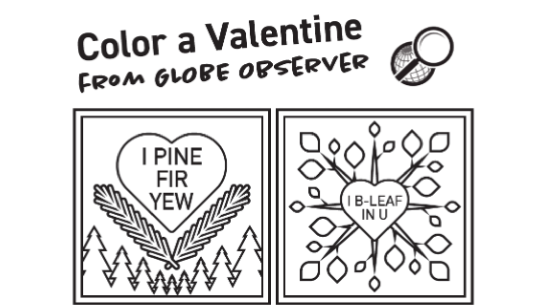GLOBE Observer At Home - GLOBE Observer
GLOBE Observer at Home
Short link to this page: https://observer.globe.gov/at-home
Looking for ways to do science at home? Here are some GLOBE Observer resources to do right where you are!
Always follow guidelines from your local officials, and only participate in GLOBE activities or use the GLOBE Observer app if it is safe to do so.
Highlighted Resource

Color a valentine with GLOBE Observer! We've taken a few of our favorite valentines created in previous years, and turned them into coloring pages, ready to customize and give to that special someone on February 14th or anytime!
Explore Virtually
You can look at scientific observations from around the world using the GLOBE Visualization System. Follow in the footsteps of Lewis and Clark, take an outback trip across Australia, or find interesting locations near you, all from your computer.
To get started, check out these data sets. In the Vis system, simply click on a thumbnail on the map and open the Photos tab to explore the world from your computer. We also have more detailed data access tutorials on the Get Data page.
Distance Learning via eTraining
If you have been enjoying the tools in the GLOBE Observer app, take some time to learn more and explore the rest of the 50+ data collection protocols in the GLOBE Program via eTraining. Each training module includes a PowerPoint presentation and a short quiz. Make sure you are logged in to your GLOBE Observer account to get credit for taking the training!
Activities to Do at Home
In our toolkit for informal educators, you can find books, videos, and activities related to the four tools within the GLOBE Observer app. We also have a specific Clouds Family Guide and a Trees Family Guide with tips and suggestions for how you and your family can participate with GLOBE.
La Guía para Familia de Nubes también está disponible en español, incluyendo vídeos con ejemplos de actividades.
Activities:
Many of these activities require common materials that are available at home, and some can be done online. We have a few demo videos from the GLOBE @ Home playlist:
And here are some more activity ideas to get you started:
Simple Instructions for how to build a paper clinometer (an instrument used to measure angles) and use it to calculate the height of a tree.

Build a Dust Storm in a Tray Activity Demo
[8:03] Dust storms take place in many locations around the world and can be quite dangerous. In this video you will learn more about dust storms with atmospheric scientist Marilé Colón Robles, and you also will learn how you can safely observe them as a citizen scientist.
Build a do-it-yourself mosquito trap using simple materials. The trap tricks mosquitoes into laying their eggs in a container that the larvae can’t escape. You can then report the larvae using the Mosquito Habitat Mapper tool in the GLOBE Observer app. Set up a trap and monitor it over time to track when mosquitoes are appearing in your area.
Create a cloud collage and ask your friends to guess the percentage of cloud cover. Expand or adapt this activity by printing photos of the sky and asking participants to identify the cloud coverage.
See a video demonstration of Estimating Cloud Cover as a family activity (YouTube)
Cloud Cover Estimation - Interactive
This interactive web-based tool allows you to calibrate your eye by practicing cloud cover estimation using images on the computer.
Cloud Type Practice - Interactive
This interactive web-based tool asks a series of questions to help you narrow down the type of cloud you are observing. It can be used both for practice and in the field to identify clouds. Based on the original Cloud Identification Key developed by Dr. Tina Cartwright, Marshall University, West Virginia
Clouds or Snow: A Satellite Mystery
This issue of Earth Observatory for Kids explains how clouds and snow can look the same from a distance, and how satellites can tell the difference by measuring light that humans cannot see. The accompanying activity is "Make Your Own Cloud (In a Bottle)"
Watch a video demonstration of the cloud in a bottle activity.
Mosquito Habitats and Hideouts Activity
Gain familiarity with the variety of container mosquito habitats, hideouts, and life cycle stages with these games! Mosquito Habitats and Hideouts can be played three different ways: Bingo, Name That Habitat, or Sketch That Habitat.
Books:
We have booklists for children and adults on WorldCat. WorldCat is useful for finding eBooks that you can borrow or buy, so that you can keep on reading without ever leaving home. Many library systems offer services like Overdrive and Hoopla, which you can access online using your library card. Simply click on a title, select “View all formats and editions,” and find an eBook edition. After selecting an edition, scroll down to “Find a Copy Online.” Alternatively, you can search for the title right from the service that you wish to use. View our book lists.
For elementary-aged children, you can download Elementary GLOBE books for free. Each title also has associated coloring pages and activities.
Videos:
We also have videos for each of the data collection types, explaining how to make observations as well as exploring other science topics. Visit the resource library pages for Clouds, Land Cover, Mosquitoes and Trees to see them all.
Further NASA Activities:
Going beyond GLOBE Observer, there are several collections of NASA resources of at-home activities, including the main NASA at Home page, plus additional collections from NASA STEM @ Home for Students Grades K-4, NASA Science at Home, and NASA SpacePlace. In addition, a number of other NASA-connected citizen science projects can be done online without leaving home. The Landsat mission has also curated a list of activities, including instructions for how to make your own animated GIF of the landscape, a meandering river flipbook, and more.










